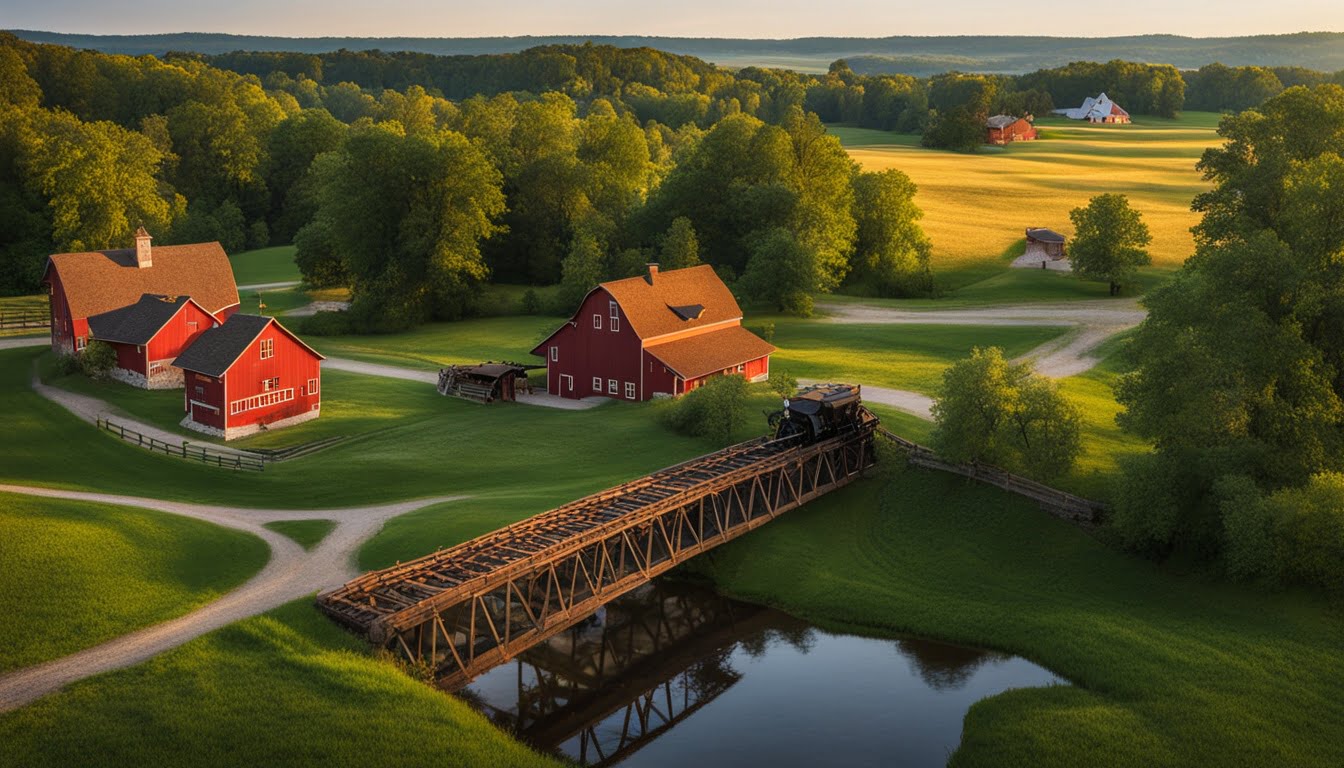Step Back in Time: Must-Visit Historical Sites Across Iowa
The Amana Colonies, Blood Run Site, and Farm House Museum all highlight Iowa’s vibrant history. They showcase Iowa’s past from different angles. Each site offers a unique look at Iowa’s cultural journey.
For example, you can visit a museum filled with Victorian era art. Or you can step onto a riverboat and feel the energy of the steamboat days. These places are filled with stories and adventures waiting to be discovered.
Key Takeaways:
- Discover Iowa’s diverse heritage through its historical sites
- Explore the Amana Colonies and learn about the German immigrants who founded this religious communal society in 1855
- Uncover the ancient history of the Blood Run Site and its significance to the Oneota and Prairie Dakota tribes
- Step inside the Farm House Museum and experience early 19th-century life at Iowa State Agricultural College
- Take a journey on the George M. Verity Riverboat and immerse yourself in the world of 19th-century riverboats
Explore Iowa’s Origins: Amana Colonies, Blood Run Site, and Farm House Museum.
The state of Iowa has a rich history. It lets visitors step back in time. The Amana Colonies, the Blood Run Site, and the Farm House Museum highlight Iowa’s beginnings.
Amana Colonies
In 1855, seven villages formed the Amana Colonies. German immigrants built them for religious freedom. Today, these villages showcase their culture and crafts. Visitors can shop for traditional items, enjoy local food, and hear the Amana people’s stories.
Blood Run Site
The Blood Run Site sits by the Big Sioux River. It was a sacred place for the Oneota and Prairie Dakota from 900 to 1720 A.D.
This site has burial mounds and old village sites. Walking through, visitors can connect with Iowa’s Native history. They’ll see the remains of a society and learn about its traditions.
Farm House Museum
Discover the past at the Farm House Museum in Ames. It was built in 1860 as part of Iowa State Agricultural College. Here, you can see over 6,000 Victorian art and antiques. These items share the story of the university’s growth.
Step into its restored rooms for a 19th-century feel.
The Amana Colonies, Blood Run Site, and Farm House Museum reflect Iowa’s early life. These places connect us to the settlers and the tribes that were here. They’re a journey through Iowa’s complex and fascinating history.
Uncover Iowa’s History: George M. Verity Riverboat, Old Capitol, and Sergeant Floyd Monument.
The George M. Verity Riverboat was built in 1927, in the riverboats’ golden age. It gives us a look at a time when boating was vital. Step on and see the original boiler, machinery, crew quarters, and pilothouse. Look at the artifacts and photos from the 19th century. They show us the life on riverboats back then.
Visit the Old Capitol in Iowa City to see a piece of history. It was the last capitol of the Iowa Territory and the first State Capitol. Take a walk through its rooms and experience the displays of Iowa’s story. You’ll learn a lot about its history, culture, and heritage.
Head to Sioux City to see the Sergeant Floyd Monument. It’s a 100-foot-tall white obelisk. It’s a tribute to Sergeant Charles Floyd, from the 1804 Lewis and Clark Expedition. As one of the first National Historic Landmarks, it offers amazing views of Sioux City and the Missouri River valley.







